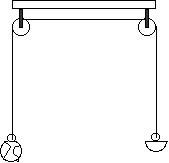
An Atwood's machine which makes a baseball fall with martian acceleration.
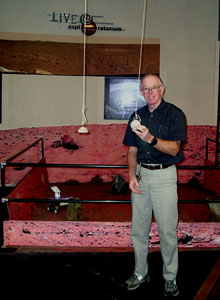
A Martian baseball counterbalanced by a half baseball on a pully
system falls at 1/3 g.
How things move in the thin air and lower gravity of Mars.
Notes:
Baseball
The acceleration of gravity is 1/3 what it is on earth. So a ball hit into the air stays in the air for three times longer. It goes 3 times higher. You can hit a ball more than 3 times further.
I say "more than" three times because the air drag is so much less on mars, (even without lift from a spinning ball.)
You can hit 1000 foot home runs on Mars. So fields will have to be 3 times longer and 3 times wader. Fielders will have to cover 9 times the area. Luckily they have a longer time to do it. Unluckily their top speed on Mars is reduced.
They may even have to use the kangaroo hop that astronauts on the moon found to be a good way to cover distance. DVD of astronaut motion on the moon.
Demo
Make an Atwoods machine with a baseball counterbalanced over two pulleys with a half baseball. The whole baseball will fall at 1/3 gravity. Drop it and toss it to see how it might move on Mars.


A Martian baseball counterbalanced by a half baseball on a pully
system falls at 1/3 g.
Pitchers cannot throw curve balls on Mars. Usually the threads on the spinning ball throw air to the side and make the ball curve by what is known as the Magnus effect. The air on mars is 100 times less dense than the air on earth so the spinning ball gets little thrust from the little air it deflects. It will deflect 100 times less distance on Mars.
Frisbee on Mars. A Frisbee on Mars has 100 times less lift than on earth but there is only 1/3 of the gravity. So a frisbee on Mars has an effective lift of 30 times less than on earth.
It's hard to remove the lift from a Frisbee however we can show the same effect on earth by making a Frisbee 30 times heavier.
Demo, Make a Frisbee 30 times heavier.
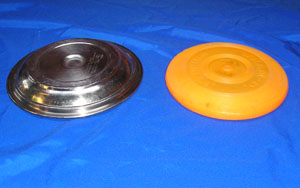
Or put spoilers on the top of a regular frisbee to reduce the lift to 1/30 of its usual value.
Falling
It's not a sport, but I do it in many sports!
To drop to the ground from a given height only takes 1.7 times as long on Mars (the square root of 3 times as long.)
Doing the math:
Distance d= 1/2 at^2 where a is acceleraion and t is time. Solve for t, on earth t = (2/g)^0.5 on Mars t = (2/0.33g)^0.5, o on mars the time to fall a given distance is the time it takes to fall the same distance on earth divided by the square root of 3, which is about 1.7.
Dancing
Your boombox would not boom as loudly on Mars. But the human ear is a good sound detector, and the background noises on mars will be quieter too.
Demo
We'll put a boombox into a chamber and listen to it at earth pressure and Mars pressure.
Paper Airplanes
Paper planes would not fly well on Mars, there is 100 times less lift in the thin air of Mars but also 1/3 of the gravity. You can model the flight of paper planes on Mars here on earth by folding paper planes from 30 sheets of paper, giving them the same lift as a normal paper plane but 30 times the mass.
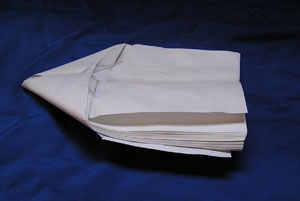
Basketball and Volleyball, You can jump 3 times higher on Mars.
Demo
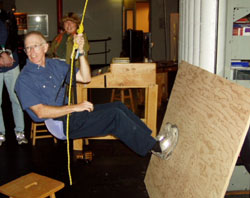
Use the Mars swingset, or
Make a human capable atwoods machine.
Put a regular basketball hoop and show that on Mars even a fifty year old white guy can stuff the ball.
Skiing, snowboarding, water ice does is not slippery at Mars nighttime temperatures. But it does warm up during the day. However, dry ice skiing might be great with a heated board.
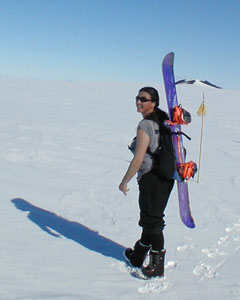
Demo Dry ice slider.
Skateboarding, you get 3 time the hang time on Mars, you can Ollie 3 times higher, but you'll need to practice the timing. You can Ollie 3 times further.
Anyone who can do a 720 turn on earth can do a 2160 on Mars.
Golf
Mars is one big sand trap. At least there are no water hazards, but there are no greens either.
Hooks and slices will be 100 times smaller per second of flight time for the ball due to the 100 times thinner atmosphere. The drives will be in the air 3 times longer and go 3 times further. But your slice distance will still be less. 1/100 * 3^2 = 1/10 as much. Still not enough to help me. And professional players use hooks and slices to navigate some fairways.
Swimming and Surfing
Even with 1/3 the gravity, you would still float exactly the same on Mars. The gravity pull on you is 1/3 what it is on earth, and the gravity pull on the water is too.
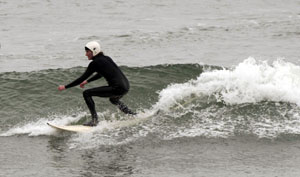
However the speed of water waves, so called gravity waves, on mars would be less than on earth. The speed of a wave is proportional to the square root of the acceleration of gravity on a planet. So the same water wave on mars would travel (1/3)^0.5 times slower, 1/1.7 or about 0.6 times as fast as on earth.
The speed of a swimmer is limited by the speed of the water wave they push along with them, thus swimming speeds on Mars would be 0.6 times what they would be on earth.
|
Scientific Explorations with Paul Doherty |
|
25 Dec 2003 |